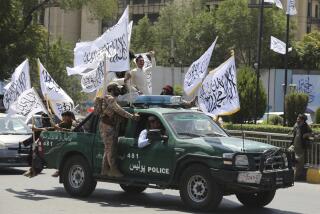Sinfulness is Skin-Deep on Streets of Iran : Islam: A stray wisp of hair or a bare chest can bring public floggings in a land where morality is a matter of attire.
- Share via
NICOSIA — It’s summertime and Iranian vice patrols are on the prowl in Tehran. They are looking for women--and men--who show too much of their bodies and too little respect for Islam’s strict dress code.
Bare arms are banned. So are tight clothes displaying curves. Even a wisp of female hair escaping from a head scarf is forbidden.
The patrols arrested 20 people on the first day they started roaming the streets of the Iranian capital in an official campaign to “Fight Manifestations of Corruption.”
Revolutionary Guards are combing the nearby Alborz mountains in pursuit of hikers breaking the dress code. Even computers have been brought into the battle against the Bad-hejab (improperly dressed) citizens.
Iran’s top judge, Mohammed Yazdi, even entered the fray, urging Islamic tribunals to clamp down on infringements of the dress code.
“Judicial courts should vigorously deal with those groups of individuals who will not reform through advice and guidance and continue to take no heed of public virtue,” he said.
The campaign begins annually at the start of summer, when women cast off heavy clothing after the harsh winter. Vice patrols stop women wearing makeup or failing to cover up everything but their face and hands.
Not that men are spared. Short-sleeved shirts are out, and bare-chested males run the risk of public flogging.
“A lady’s face and hands from the wrist down can be exposed, but the rest of the body must be covered,” the governor-general of Tehran province, Mahmoud Taheri, told Iranian television.
“The hair, neck, chest, arms and legs must all be covered. . . . A smock should not be so tight as to reveal curves. . . . Such a thing would lead to vice and corruption.”
Violators of either sex can receive up to 74 lashes, and authorities have said names of lesser offenders will be kept on a computer. Persistent offenders are likely to lose their jobs.
The campaign is aimed mainly at middle-class women who dare to go out in bright clothes, thin stockings and with hair protruding from scarves--in defiance of Iran’s clerical rulers, who equate chaste behavior with following the Islamic dress code.
The display of women’s hair is considered especially objectionable.
Former President Abolhassan Bani-Sadr, now a political exile in France, fueled a national debate on the issue soon after the 1979 Islamic Revolution which overthrew the shah. A woman’s hair, he argued, sent out special rays arousing men.
Tehran residents said this year’s campaign was more organized than before, when zealots would cruise the capital on motorbikes and beat up women showing their locks on the street.
Residents said the street thugs had all but disappeared, leaving the campaign to the official vice squads.
The squads, assisted by Revolutionary Guards, are deployed at key intersections to watch for offenders. Restaurants, government offices, movie theaters and schools are under instructions to refuse entry to those not complying with the dress code, they said.
While wealthy women in north Tehran balk at the restrictions, many of their poorer sisters in the south willingly accept them.
And television does show some exceptions to the great cover-up--male wrestlers and soccer players and women in foreign films.
More to Read
Sign up for Essential California
The most important California stories and recommendations in your inbox every morning.
You may occasionally receive promotional content from the Los Angeles Times.













